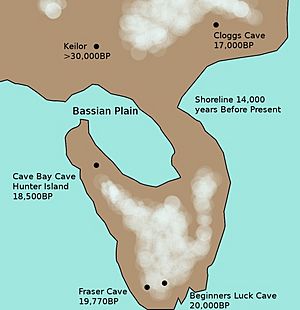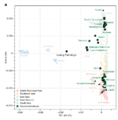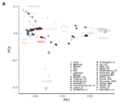Prehistory of Australia facts for kids
The prehistory of Australia is the period between the first human habitation of the Australian continent and the colonisation of Australia in 1788, which marks the start of consistent written documentation of Australia. This period has been variously estimated, with most evidence suggesting that it goes back between 50,000 and 65,000 years.
This era is referred as prehistory rather than history because of the lack of written documentation of human events. As no metal technology was developed, the whole period falls into the Stone Age. Australia, in contrast to New Guinea, has generally been held not to have had a Neolithic period, with a hunter-gatherer lifestyle continuing until the arrival of Europeans, although there is evidence of land management by practices such as cultural burning, and in some areas, agriculture, fish farming, and permanent settlements.
Contents
Arrival
There is considerable discussion among archeologists as to the route taken by the first migrants to Australia, widely taken to be ancestors of the modern Aborigines. Migration took place during the closing stages of the Pleistocene, when sea levels were much lower than they are today. Repeated episodes of extended glaciation during the Pleistocene epoch resulted in decreases of sea levels by more than 100 metres in Australasia. People appear to have arrived by sea during a period of glaciation, when New Guinea and Tasmania were joined to the continent of Australia.
The continental coastline extended much further out into the Timor Sea, and Australia and New Guinea formed a single landmass (known as Sahul), connected by an extensive land bridge across the Arafura Sea, Gulf of Carpentaria and Torres Strait. Nevertheless, the sea still presented a major obstacle so it is theorised that these ancestral people reached Australia by island hopping. Two routes have been proposed. One follows an island chain between Sulawesi and New Guinea and the other reaches North Western Australia via Timor. Rupert Gerritsen has suggested an alternative theory, involving accidental colonisation as a result of tsunamis. The journey still required sea travel however, making them amongst the world's earlier mariners.
Scott Cane wrote in 2013 that the first wave may have been prompted by the eruption of Mount Toba and if they arrived around 70,000 years ago could have crossed the water from Timor, when the sea level was low - but if they came later, around 50,000 years ago, a more likely route would be through the Moluccas to New Guinea. Given that the likely landfall regions have been under around 50 metres of water for the last 15,000 years, it is unlikely that the timing will ever be established with certainty.
The minimum widely accepted timeframe for the arrival of humans in Australia is placed at least 40,000 years ago. Many sites dating from this time period have been excavated. In Arnhem Land the Malakunanja II rock shelter "has been dated to around 55,000 years old".
Radiocarbon dating suggests that they lived in and around Sydney for at least 30,000 years. In an archaeological dig in Parramatta, Western Sydney, it was found that the Aboriginals used charcoal, stone tools and possible ancient campfires. Near Penrith, a far western suburb of Sydney, numerous Aboriginal stone tools were found in Cranebrook Terraces gravel sediments having dates of 45,000 to 50,000 years BP. This would mean that there was human settlement in Sydney earlier than thought.
Archaeological evidence indicates human habitation at the upper Swan River, Western Australia by about 40,000 years ago. Tasmania, which was connected to the continent by a land bridge, was inhabited at least 30,000 years ago. Others have claimed that some sites are up to 60,000 years old, but these claims are not universally accepted. Palynological evidence from South Eastern Australia suggests an increase in fire activity dating from around 120,000 years ago. This has been interpreted as representing human activity, but the dating of the evidence has been strongly challenged.
Charles Dortch has identified chert and calcrete flake stone tools, found at Rottnest Island in Western Australia, as possibly dating to at least 50,000 years ago. This seems to tie in accurately with U/Th and 14C results of a flint tool found embedded in Tamala limestone (Aminozone C) as well as both mtDNA and Y chromosome studies on the genetic distance of Australian Aboriginal genomes from African and other Eurasian ones.
The sharing of animal and plant species between Australia-New Guinea and nearby Indonesian islands is another consequence of the early land bridges, which closed when sea levels rose with the end of the last glacial period. The sea level stabilised to near its present levels about 6000 years ago, flooding the land bridge between Australia and New Guinea.
It is unknown how many populations settled in Australia prior to European colonisation. Both "trihybrid" and single-origin hypotheses have received extensive discussion. Keith Windshuttle, known for his belief that Aboriginal pre-history has become politicised, argues that the assumption of a single origin is tied into ethnic solidarity, and multiple entry was suppressed because it could be used to justify white seizure of Aboriginal lands.
Human genomic differences are being studied to find possible answers, but there is still insufficient evidence to distinguish a "wave invasion model" from a "single settlement" one. Some Y chromosomal studies indicate a recent influx of Y chromosomes from the Indian subcontinent. A 2012 paper by Alan J. Redd et al. on this topic notes that the indicated influx period corresponds to the timing of various other changes, specifically mentioning "The divergence times reported here correspond with a series of changes in the Australian anthropological record between 5,000 years ago and 3,000 years ago, including the introduction of the dingo; the spread of the Australian Small Tool tradition; the appearance of plant-processing technologies, especially complex detoxification of cycads; and the expansion of the Pama-Nyungan language over seven-eighths of Australia." Although previously linked to the pariah dogs of India, recent testing of the mitochondrial DNA of dingos shows a closer connection to the dogs of Eastern Asia and North America, suggesting an introduction as a result of the Austronesian expansion from Southern China to Timor over the last 5000 years. The recent finding of kangaroo ticks on the pariah dogs of Thailand further suggests that this genetic expansion may have been a two-way process.
Advent of fire farming and megafauna extinctions
Archaeological evidence (in the form of charcoal) indicates that fire, over 100,000 years (from ash deposits in the Coral Sea) was already a growing part of the Australian landscape. Over the last 70,000 years it became much more frequent as hunter-gatherers used it as a tool to drive game, to produce a green flush of new growth to attract animals, and to open up impenetrable forest. Densely grown areas became more open sclerophyll forest, open forest became grassland. Fire-tolerant species became predominant: in particular, eucalyptus, acacia, banksia, casuarina and grasses.
The changes to the fauna were even more dramatic: the megafauna, species significantly larger than humans, disappeared, and many of the smaller species disappeared too. All told, about 60 different vertebrates became extinct, including the Diprotodon family (very large marsupial herbivores that looked rather like hippos), several large flightless birds, carnivorous kangaroos, Wonambi naracoortensis, a 5-metre snake, a five-metre lizard and Meiolania, a tortoise the size of a small car.
The direct cause of the mass extinctions is uncertain: it may have been fire, hunting, climate change or a combination of all or any of these factors, although the rapid decline of many species is still a matter of dispute. With no large herbivores to keep the understorey vegetation down and rapidly recycle soil nutrients with their dung, fuel build-up became more rapid and fires burned hotter, further changing the landscape. Against this theory is the evidence that in fact careful seasonal fires from Aboriginal land management practices reduced fuel loads, and prevent wildfires like those seen since European settlement.
The period from 18,000 to 15,000 years ago saw increased aridity of the continent with lower temperatures and less rainfall than currently prevails. Between 16,000 and 14,000 years BP the rate of sea level rise was most rapid rising about 50 feet in 300 years according to Peter D. Ward. At the end of the Pleistocene, roughly 13,000 years ago, the Torres Strait connection, the Bassian Plain between modern-day Victoria and Tasmania, and the link from Kangaroo Island began disappearing under the rising sea. Various Aboriginal groups seem to have preserved oral histories of the Flandrian sea level rise, in the Kimberley and Northern Australia and also in the isolation of Rottnest Island from the southwestern Western Australian coast 12,000 years ago. The finding of a chert deposit in the strait between the island and the mainland, and the use of chert as a predominate rock in the lithic industries of the region, enables the date to be fairly well established.
From that time on, the Tasmanian Aborigines were geographically isolated. By 9,000 years ago small islands in Bass Strait, as well as Kangaroo Island were no longer inhabited.
Linguistic and genetic evidence shows that there has been long-term contact between Australians in the far north and the Austronesian people of modern-day New Guinea and the islands, but that this appears to have been mostly trade with a little intermarriage, as opposed to direct colonisation. Macassan praus are also recorded in the Aboriginal stories from Broome to the Gulf of Carpentaria, and there were some semi-permanent settlements established, and cases of Aboriginal settlers finding a home in Indonesia.
Culture and technology
The last 5,000 years were characterised by a general amelioration of the climate and an increase in temperature and rainfall and the development of a sophisticated tribal social structure. The main items of trade were songs and dances, along with flint, precious stones, shells, seeds, spears, food items, etc.
The Pama–Nyungan language family, which extends from Cape York to the southwest, covered all of Australia except for the southeast and Arnhem Land. There was also a marked continuity of religious ideas and stories throughout the country, with some songlines crossing from one side of the continent to the other.
The initiation of young boys and girls into adult knowledge was marked by ceremony and feasting. Behaviour was governed by strict rules regarding responsibilities to and from uncles, aunts, brothers and sisters as well as in-laws. The kinship systems observed by many communities included a division into moieties, with restrictions on intermarrying dictated by the moiety an individual belonged to.
Describing prehistoric Aboriginal culture and society during her 1999 Boyer Lecture, Australian historian and anthropologist Inga Clendinnen explained:
"They [...] developed steepling thought-structures – intellectual edifices so comprehensive that every creature and plant had its place within it. They travelled light, but they were walking atlases, and walking encyclopedias of natural history. [...] Detailed observations of nature were elevated into drama by the development of multiple and multi-level narratives: narratives which made the intricate relationships between these observed phenomena memorable.
These dramatic narratives identified the recurrent and therefore the timeless and the significant within the fleeting and the idiosyncratic. They were also very human, charged with moral significance but with pathos, and with humour, too – after all, the Dreamtime creatures were not austere divinities, but fallible beings who happened to make the world and everything in it while going about their creaturely business. Traditional Aboriginal culture effortlessly fuses areas of understanding which Europeans 'naturally' keep separate: ecology, cosmology, theology, social morality, art, comedy, tragedy – the observed and the richly imagined fused into a seamless whole."
Political and religious power rested with community elders rather than hereditary chiefs. Disputes were settled communally in accordance with an elaborate system of tribal law. Vendettas and feuds were not uncommon, especially when laws and taboos were broken. Cremation of the dead was practised by 25,000 years ago, possibly before anywhere else on Earth, and early artwork in Koonalda Cave, Nullarbor Plain, has been dated back to 20,000 years ago.
It has been estimated that in 1788 there were approximately half a million Australian Aboriginal people, although other estimates have put the figure as high as a million or more. These populations formed hundreds of distinct cultural and language groups. Most were hunter-gatherers with rich oral histories and advanced land-management practices developed over thousands of years since the ecological destruction of the initial colonisation phase.
In the most fertile and populous areas, they lived in semi-permanent settlements. In the fertile Murray Basin, the gathering and hunting economies to be found elsewhere on the continent had in large part given way to fish farming. Sturt's expedition along the Murray led to a belief that the Aboriginal groups there were practicing agriculture as a result of the presence of large haystacks, used as permanent grain stores.
Little interest was shown by white settlers in the bulk of the Aboriginal people, and so little is known of their cultures and languages. Diseases decimated some indigenous populations just prior to the period where most Aborigines came into direct contact with Europeans. When Cook first claimed New South Wales for Britain in 1770, the native population may have consisted of as many as 600 distinct tribes speaking 200–250 distinct languages and over 600 distinct dialects and sub-dialects.
Contact outside Australia
Aboriginal people have no cultural memory of living anywhere outside Australia. Nevertheless, the people living along the northern coastline of Australia, in the Kimberley, Arnhem Land, Gulf of Carpentaria and Cape York had encounters with various visitors for many thousands of years. People and traded goods moved freely between Australia and New Guinea up to and even after the eventual flooding of the land bridge by rising sea levels, which was completed about 6000 years ago.
However, trade and intercourse between the separated lands continued across the newly formed Torres Strait, whose 150 km-wide channel remained readily navigable with the chain of Torres Strait Islands and reefs affording intermediary stopping points. The islands were settled by different seafaring Melanesian cultures such as the Torres Strait Islanders over 2500 years ago, and cultural interactions continued via this route with the Aboriginal people of northeast Australia.
Indonesian "Bajau" fishermen from the Spice Islands (e.g. Banda) have fished off the coast of Australia for hundreds of years. Macassan traders from Sulawesi regularly visited the coast of northern Australia to fish for trepang, an edible sea cucumber to trade with the Chinese since at least the early 18th century. Tamil sea-farers also had knowledge of Australia and Polynesia before European contact.
There was a high degree of cultural exchange, evidenced in Aboriginal rock and bark paintings, the introduction of technologies such as dug-out canoes and items such as tobacco and tobacco pipes, Macassan words in Aboriginal languages (e.g. Balanda for white person), and descendants of Malay people in Australian Aboriginal communities and vice versa, as a result of intermarriage and migration.
The myths of the people of Arnhem Land have preserved accounts of the trepang-catching, rice-growing Baijini people, who, according to the myths, were in Australia in the earliest times, before the Macassans. The Baijini have been variously interpreted by modern researchers as a different group of presumably South East Asian people, such as Bajau visitors to Australia who may have visited Arnhem Land before the Macassans, as a mythological reflection of the experiences of some Yolŋu people who have travelled to Sulawesi with the Macassans and came back, or, in more fringe views, even as visitors from China.
Possible link to east Africa
In 1944, a small number of copper coins with Arabic inscriptions were discovered on a beach in Jensen Bay on Marchinbar Island, part of the Wessel Islands of the Northern Territory. These coins were later identified as from the Kilwa Sultanate of east Africa. Only one such coin had ever previously been found outside east Africa (unearthed during an excavation in Oman). The inscriptions on the Jensen Bay coins identify a ruling Sultan of Kilwa, but it is unclear whether the ruler was from the 10th century or the 14th century. This discovery has been of interest to those historians who believe it likely that people made landfall in Australia or its offshore islands before the first generally accepted such discovery, by the Dutch sailor Willem Janszoon in 1606. (See Janszoon voyage of 1605–06 and European exploration of Australia.)
Images for kids
See also
 In Spanish: Prehistoria de Australia para niños
In Spanish: Prehistoria de Australia para niños





